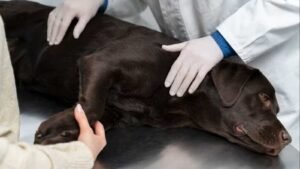Cancer occurs at a proportional rate in dogs and cats as it does in people. Cats appear to acquire cancer at a lower rate than humans, but dogs appear to develop cancer at a higher rate than humans. Cancer is more likely to arise in most species as they get older. Cancer, for example, is more frequent in pets aged 10 years or older. Cancer accounts for little under half of all deaths in dogs aged 10 and over. Even young animals, however, can acquire cancer; age is not the main determinant in cancer formation.
Symptoms Of Cancer
These and other changes in a pet’s behavior or appearance might be signs of cancer. Even while these changes aren’t necessarily indicative of cancer, seeing them and alerting your veterinarian to them right away might improve the likelihood that cancer will be discovered and treated early. “Listed below”:-
- Lymph nodes that be swollen
- Swelling of the abdomen that develops suddenly
- Bleeding from the mouth, nose, or genital region for no apparent reason
- Breathing, eating, swallowing, urinating, and defecating difficulties.
- Itching or swelling that does not go away
- Bad breath or other odor that is unexplained
- Coughing up a dry mucus
- Weakened physical stamina
- The occurrence of recurrent nausea or vomiting
Cancer Treatment
If your pet has neoplasia, your veterinarian has several treatment choices. Surgery, chemotherapy, and radiation therapy are the three most frequent treatments for animal cancer and tumors (also called radiotherapy).
Each of these therapies can be used alone or in conjunction with others. Your veterinarian will prescribe a treatment plan based on your pet’s unique condition. This depends on the type of cancer and how rapidly it develops and spreads (the stage or grade of cancer). Your veterinarian will also look at its location.
1) Surgical Method
Surgical treatment is most favorable when the cancer is contained within a tumor that has not spread. Although some tumors may be eliminated by surgery, unfortunately, not all of them can. Other projects have been tasked with working in inaccessible areas. At times, the animal’s costs may exceed its advantages. When a big tumor is removed, a key organ may be removed or a vital bodily function may be lost. Because of this, surgery alone may not be as successful if cancer has metastasized (spread beyond one area).
To minimize or prevent the adverse effects of various therapies, your veterinarian may also recommend surgery. Radiation treatment, for example, can harm normal, healthy tissue. The injured tissue can be removed, which will promote a faster healing process. A feeding tube may also be surgically implanted in instances where cancer or its treatment makes regular eating physically impossible or extremely unpleasant.
2) Radiation Therapy
An animal’s body can also be treated with internal radiation therapy, although this is an uncommon option. A radioactive material inserted in the tumor delivers radiation doses to the tumor and the surrounding area (such as cobalt). Brachytherapy is the name given to this procedure. Because the radioactive material must be handled with care and kept within the tumor to avoid exposing people, other animals, or healthy bodily parts of the pet being treated, it is seldom used to treat cancer in animals Radioactive iodine is used to treat thyroid adenomas in cats. Continue to develop implantable radiation sources, which are tiny enough to be permanently placed within the body.
3) Chemotherapy
In an animal’s body, a chemotherapy medication would kill cancer cells without damaging normal healthy cells and vice versa. Few of these medicines have been discovered thus far. Chemotherapy medicines are now intended to be more toxic to cancer cells than to normal cells, which is why they are being used. Cells that divide and expand fast are the ones that are targeted by these drugs. In certain cases, chemotherapy medicines might have harmful effects on normal cells. Alternatively, chemotherapeutic medicines can be administered by mouth or injection. If an injection is utilized, it can be prescribed by doctors, multiple doses, or subcutaneously (intradermally) (subcutaneous). The mode of delivery will be chosen based on the patient’s comfort and quality of life. Chemotherapy kills cancer cells without harming healthy cells in an animal’s body, and the reverse is true.


